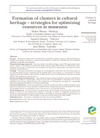Please use this identifier to cite or link to this item:
https://accedacris.ulpgc.es/jspui/handle/10553/106280
| DC Field | Value | Language |
|---|---|---|
| dc.contributor.author | Moreno Mendoza, Héctor | en_US |
| dc.contributor.author | Santana Talavera, Agustín | en_US |
| dc.contributor.author | Molina González,José | en_US |
| dc.date.accessioned | 2021-03-26T12:46:22Z | - |
| dc.date.available | 2021-03-26T12:46:22Z | - |
| dc.date.issued | 2021 | en_US |
| dc.identifier.issn | 2044-1266 | en_US |
| dc.identifier.other | Scopus | - |
| dc.identifier.uri | https://accedacris.ulpgc.es/handle/10553/106280 | - |
| dc.description.abstract | Purpose: The purpose of this study is to affirm that it is possible to segment visitors of cultural heritage into homogeneous groups according to a series of characteristics to detect the variables that have statistical significance to identify visitor clusters. Design/methodology/approach: Four case studies were selected, where a total of 500 questionnaires were made to visitors. The authors proceeded with cluster analysis using SPSS software to differentiate visitor segments. Four groups of visitors were first identified and which have subsequently been reduced to three, according to several factors. Findings: The main contributions of this paper are: (1) the segment to which each one of the determinants of the cultural tourism product is dedicated; (2) the variable object of the analysis, i.e. the formation of visitor segments; and (3) the inclusion of less studied variables such as type of accommodation contracted, treatment offered in the museums or entrance price. Research limitations/implications: The analysis has been developed in different museums, with different management models, in a specific place. However, the results are generalizable to other places and to other institutions that manage cultural heritage. The implications are management strategies for a sustainable cultural development in institutions of tourism and heritage. Practical implications: From a practical point of view, the results are useful for cultural managers, travel agencies, tour operators, tourism companies or political offices, among others, because they generate new ideas and strategies focused on maximizing the use of the resources of cultural institutions. Social implications: For both local and non-local agents, the knowledge of the factors that make up the groups of visitors in the heritage sites represents a strategy in aspects of marketing, promotion and distribution, thus generating capacities for the different intermediaries, and the possibility of negotiating lower prices with better benefits. It is also possible to create new products destined for other publics. Originality/value: The study is original because this has not been published. | en_US |
| dc.language | eng | en_US |
| dc.relation.ispartof | Journal of Cultural Heritage Management and Sustainable Development | en_US |
| dc.source | Journal of Cultural Heritage Management and Sustainable Development [ISSN 2044-1266], v. 11(4), p. 580-595 | en_US |
| dc.subject | 531290 Economía sectorial: turismo | en_US |
| dc.subject.other | Cultural Tourism Product | en_US |
| dc.subject.other | Museum Offer | en_US |
| dc.subject.other | Museums | en_US |
| dc.subject.other | Segmentation | en_US |
| dc.subject.other | Visit Factors | en_US |
| dc.title | Formation of clusters in cultural heritage – strategies for optimizing resources in museums | en_US |
| dc.type | info:eu-repo/semantics/article | en_US |
| dc.type | article | en_US |
| dc.identifier.doi | 10.1108/JCHMSD-12-2019-0155 | en_US |
| dc.identifier.scopus | 85101231387 | - |
| dc.contributor.authorscopusid | 57209716675 | - |
| dc.contributor.authorscopusid | 57221300169 | - |
| dc.contributor.authorscopusid | 57222059609 | - |
| dc.identifier.eissn | 2044-1274 | - |
| dc.investigacion | Ciencias Sociales y Jurídicas | en_US |
| dc.type2 | Artículo | en_US |
| dc.utils.revision | Sí | en_US |
| dc.date.coverdate | Enero 2021 | en_US |
| dc.identifier.ulpgc | Sí | en_US |
| dc.contributor.buulpgc | BU-ECO | en_US |
| dc.description.sjr | 0,325 | |
| dc.description.sjrq | Q1 | |
| dc.description.esci | ESCI | |
| dc.description.miaricds | 9,5 | |
| item.fulltext | Con texto completo | - |
| item.grantfulltext | open | - |
| crisitem.author.dept | GIR Investigación en Arqueología y Patrimonio | - |
| crisitem.author.orcid | 0000-0001-9442-1110 | - |
| crisitem.author.parentorg | Departamento de Ciencias Históricas | - |
| crisitem.author.fullName | Molina González, José | - |
| Appears in Collections: | Artículos | |
SCOPUSTM
Citations
9
checked on Jun 8, 2025
WEB OF SCIENCETM
Citations
7
checked on Jun 8, 2025
Page view(s)
228
checked on Oct 31, 2024
Download(s)
322
checked on Oct 31, 2024
Google ScholarTM
Check
Altmetric
Share
Export metadata
Items in accedaCRIS are protected by copyright, with all rights reserved, unless otherwise indicated.
